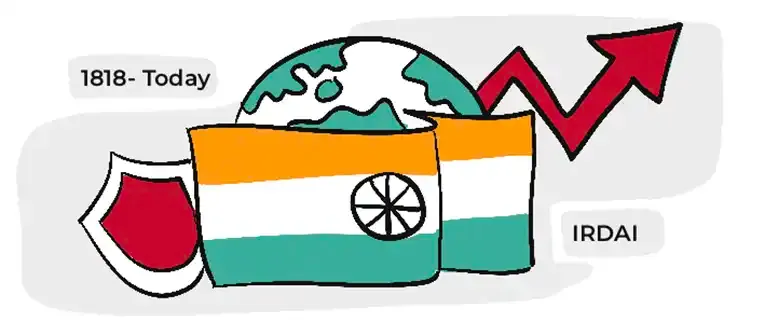Now that you are aware of how the Indian insurance market has evolved over the years, let's look at the types of insurance products available in India.
Types Of Life Insurance Products
In the Indian market, there are two main types of insurance products available -
● Life Insurance Products
These are long-term financial products that offer insurance protection for a specific period or your entire life. In addition to providing risk coverage for life, some life insurance products also provide long-term investment benefits that help you achieve financial goals, like securing the future of your child, planning for your retirement, etc.
● Non-Life or General Insurance Products
These include insurance products that cover everything apart from life. Products under this category cover several types of risks. For instance -
- A motor insurance product will cover damage caused to a car or a bike
- A health insurance product will cover expenses related to hospitalisation.
- A liability insurance product will cover legal liability caused due to an accident, etc.
- A home insurance product will cover the contents and structure of your home against damages caused due to burglary, fire, etc.
Players/Stakeholders In The Life Insurance Market
There are generally 4 types of stakeholders in the life Insurance market. They are -
1. Insurance Companies
Insurance companies are the producing entities that provide insurance to the customers, i.e., you. They are responsible for designing the product, determining the price of the product, evaluating the risk of the customers, managing the coverage including renewals, and paying out the claims.
2. Intermediaries
Intermediaries are distributors of insurance products designed by insurance companies. There are different types of intermediaries and each intermediary has a different role. Some are merely responsible for selling the product, while others, such as insurance brokers, are responsible for advising and coordinating with insurance companies on behalf of the customer from purchase through claims.
Intermediaries earn a commission when they sell an insurance policy to a customer. The commission they earn is typically a percentage of the premium collected.
3. Reinsurer
Insurance companies can offer insurance to customers up to a certain level. If they don't have the capacity to provide a cover on their own, they may take the help of a reinsurer.
Reinsurers are financial service companies that provide insurance companies with additional capacity and competence. They help the insurance companies in reducing the amount of risk they face. In exchange for a premium, they give expertise, data, and financial coverage over the insurance coverage sold by the insurance company.
In simpler words, a reinsurer insures an insurance company's risk in exchange for a premium.
Apart from a big list of foreign reinsurers, India has its own stock market listed public sector reinsurance company called General Insurance Corporation.
4. Regulator
A regulator is a government entity that is responsible for regulating and overseeing the development of the players and how they operate within the insurance sector.
The Insurance And Regulatory Authority Of India (IRDAI) is the regulating body for insurance in India. They have a responsibility to regulate the insurance sector to protect the interests of consumers and facilitate the development of the sector.
Overview Of The Indian Insurance Market⁵
Some interesting numbers that will give you a good insight of where the industry stands today, and where it is headed.
➔ Current Stats
◆ India is currently ranked 11th in the global insurance business.
◆ The Indian insurance market stands at $131 Bn as of FY22 with a total written life insurance premium of $81.3 Bn.
➔ Growth Opportunity
◆ As of 2020, 68% of India's population is young, and 55% of its population is between the ages of 20 and 59 (working population). This is expected to rise to 56% by 2025 - indicating that India has a young insurable population.
◆ By 2030, India will have added 140 Mn middle-income and 21 Mn high-income households, driving demand, and expansion in the Indian insurance business.
➔ Mortality Protection Gap
◆ Mortality Protection Gap indicates the difference between the life insurance cover people already have and what they should ideally have.
◆ In India, the total mortality protection gap is $16.5 Tn (as of 2019), with an estimated protection gap of 83% of the total protection needs. This presents a big opportunity for life insurers, with a projected increased life premium opportunity of $78.2 Bn per year from 2020 to 2030.
➔ CAGR
◆ CAGR or Compounded Annual Growth Rate is the average rate of revenue growth between two given years.
◆ Over the last two decades, the Indian insurance business grew at a CAGR of 17% and is likely to maintain its remarkable growth trajectory in the coming years.
➔ FDI
◆ FDI or Foreign Direct Investment, i.e., investment made by foreign entities in the Indian insurance business increased from 49% to 74% (announced in the Union Budget, Feb'21).
◆ This FDI increase in insurance will contribute to improved insurance penetration and coverage by opening up additional avenues for capital support required for the expansion of India's insurance business.
➔ Insurance Penetration
◆ Insurance penetration is an indicator of how well developed the insurance industry is, in a country.
◆ Insurance penetration in India stood at 4.2% in FY21 (up from 3.76% in 2019-20), with life insurance penetration at 3.2% and non-life insurance penetration at 1%.
◆ The IRDAI has taken various steps to increase insurance penetration, including allowing insurers to do video-based KYC, give rewards for low-risk behaviour, creating standardised insurance products, etc.
This brings us to the end of this article. We hope you are now clear on how insurance was introduced in India, the types of insurance products available in India, and the four main players in the Indian insurance market. We will be exploring how life insurance policies work in India in the next article.





